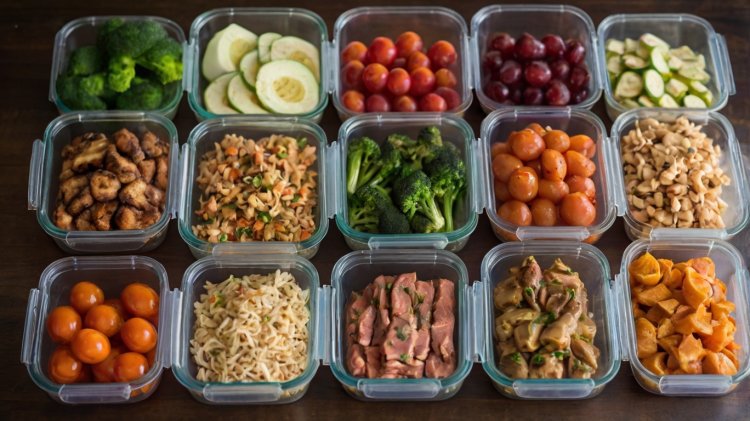Meal Planning 101: A Comprehensive Beginner’s Guide to Smart Meal Prep
Discover how to simplify your weekly meals, save time, and eat healthier with this complete beginner’s guide to meal planning. Learn essential tips, tools, recipes, and hacks to make meal prep stress-free and efficient

Meal Planning 101: A Comprehensive Beginner’s Guide to Smart Meal Prep
In today’s fast-paced world, deciding what to eat every day can be stressful, especially when juggling work, family, and social obligations. Meal planning offers a practical solution by eliminating the daily guesswork around meals, saving you time, money, and effort. Whether you're trying to eat healthier, manage dietary restrictions, or simply streamline your week, this beginner-friendly guide will teach you how to master meal prep.
What Is Meal Planning?
Meal planning involves creating a weekly menu tailored to your nutritional needs, preferences, and lifestyle. It includes preparing a list of meals in advance, shopping for ingredients, and possibly prepping some items ahead of time.
Key Benefits of Meal Planning:
- Saves Time: Reduces daily cooking and decision-making.
- Promotes Healthy Eating: Encourages balanced meals and fewer processed options.
- Cuts Costs: Prevents impulse purchases and reduces food waste.
- Simplifies Life: Streamlines busy schedules with pre-planned meals.
Types of Meal Planning
Meal planning isn’t a one-size-fits-all approach. Here are the most common styles:
- Batch Cooking: Prepare meals in bulk to store for the week.
- Portioning: Divide meals into single-serving containers for easy grab-and-go.
- Themed Nights: Assign themes to each night, like Taco Tuesday or Pasta Friday.
- Ingredient Prep: Chop, slice, or pre-cook ingredients for use in multiple recipes.
Choose the method that works best for your lifestyle and goals.
Tools You’ll Need for Successful Meal Planning
Streamline your meal prep process with these essential tools:
- Storage Containers: Use freezer- and microwave-safe containers for versatility.
- Meal-Planning App or Journal: Apps like Paprika help you organize recipes, shopping lists, and meal schedules.
- Labels: Keep track of meals with clear labels showing the dish name and prep date.
- Sharp Knife and Cutting Board: Essential for quick produce prep.
- Non-Stick Baking Sheets and Pans: Ideal for roasting vegetables or baking proteins.
Smart Grocery Shopping Tips
A well-organized grocery trip is the backbone of successful meal planning.
- Make a List: Write down exactly what you need based on your planned meals.
- Shop Seasonally: Choose seasonal produce for fresher, more affordable ingredients.
- Explore Frozen Foods: Stock up on frozen veggies, fruits, and proteins for quick meals.
- Use Pantry Staples: Keep essentials like rice, pasta, beans, and canned goods on hand.
- Buy in Bulk: For commonly used items like grains, nuts, and spices.
How to Start Meal Planning
Step 1: Set a Weekly Menu
Plan your breakfasts, lunches, dinners, and snacks for the week. Repetition is key to simplicity—opt for 2–3 rotating options for each meal type.
Step 2: Choose Easy Recipes
Focus on recipes with simple ingredients and minimal prep time.
Step 3: Prep Ingredients in Advance
Dedicate a few hours on a weekend or free day to wash, chop, and portion out ingredients.
Step 4: Store Meals Correctly
Use clear, airtight containers to keep meals fresh. Label with the date and contents to avoid confusion.
Time-Saving Meal Prep Hacks
- Double Up: Cook extra portions and freeze for future use.
- Use a Slow Cooker or Instant Pot: Perfect for hands-free meal prep.
- Batch Cook Grains and Proteins: Use them in multiple dishes throughout the week.
- Pre-Chop Veggies: Store in the fridge for quick access.
- Invest in Pre-Cut Ingredients: Saves time when life gets busy.
Meal Planning Recipes to Try
Here are a few beginner-friendly options to inspire your meal plan:
- Breakfast: Overnight oats with berries and chia seeds.
- Lunch: Grilled chicken salad with quinoa and fresh veggies.
- Dinner: Baked salmon with roasted sweet potatoes and steamed broccoli.
- Snacks: Hummus with carrot sticks or Greek yogurt with granola.
FAQs About Meal Planning
1. How can meal planning help me save money?
By planning your meals, you can avoid impulse buys, reduce eating out, and minimize food waste, ultimately cutting down on grocery expenses.
2. Is meal planning suitable for people with dietary restrictions?
Absolutely! Meal planning allows you to tailor your menu to accommodate allergies, dietary preferences, or health conditions like diabetes or gluten intolerance.
3. How long does meal prep take?
Meal prep can take anywhere from 1–3 hours, depending on how many meals you’re preparing and the complexity of your recipes.
4. What’s the best way to store prepped meals?
Use clear, airtight containers. Refrigerate meals you’ll eat within a few days and freeze the rest to maintain freshness.
5. Can I still meal plan if I don’t cook often?
Yes! Focus on no-cook meals like salads, sandwiches, and smoothie bowls. You can also incorporate store-bought items like rotisserie chicken or pre-cooked grains.
Conclusion
Meal planning is a practical way to simplify your life while eating healthier and saving money. By starting with small steps—like choosing a few recipes and prepping ingredients—you can develop a habit that benefits your schedule, budget, and overall health.









